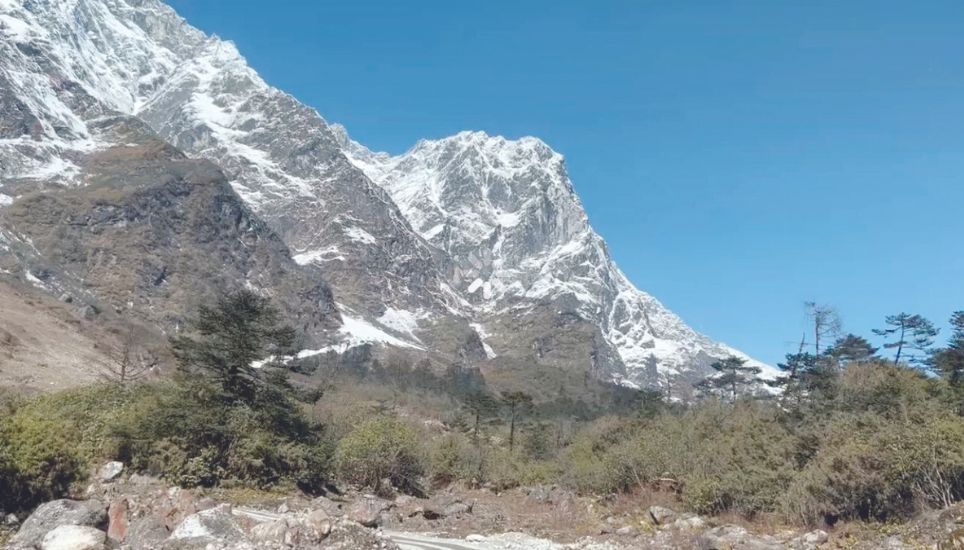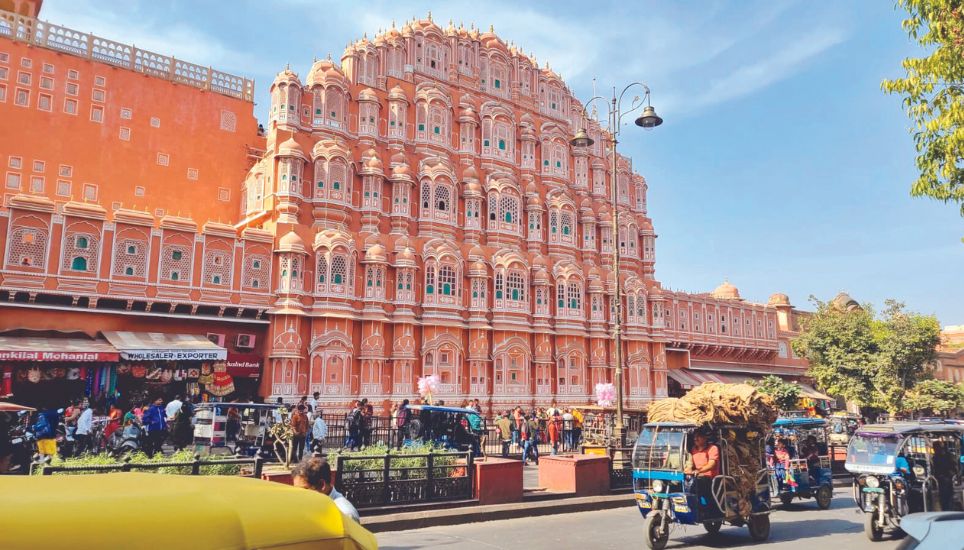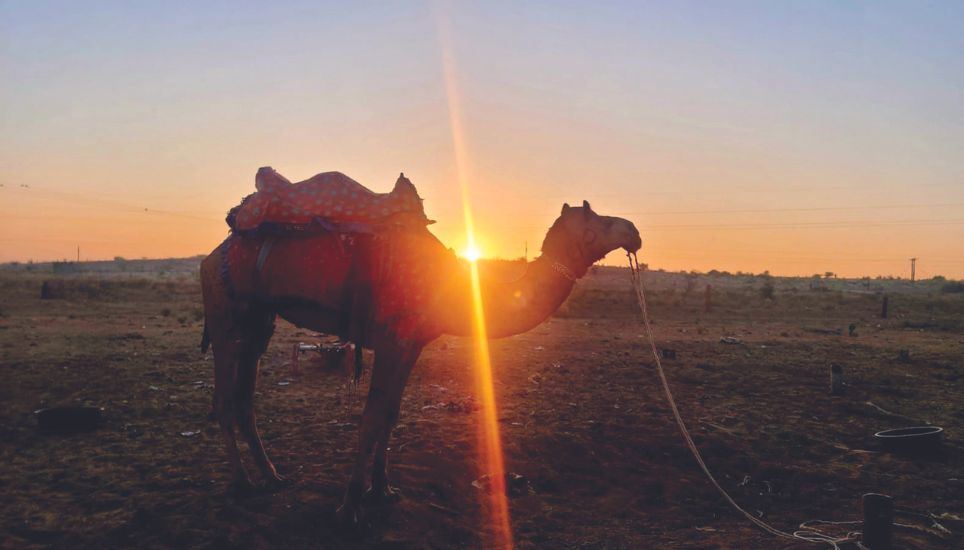
The mystical allure of India, a land steeped in rich history, vibrant culture, and breathtaking landscapes, always captivated me. Embarking on my first trip to this incredible nation, I ventured on a 26-day odyssey, traversing six states and exploring 13 cities.
This unforgettable journey unfolded amidst a mesmerising tapestry of architectural marvels – ancient forts, majestic palaces, serene temples, captivating havelis, and awe-inspiring natural wonders like desert and snowy mountains.
Each structure, a testament to the legacies of the Mughals, Maharawals, Maharajas, and Sawai Jai Singh, whispered tales of India's glorious past, offering a glimpse into the vibrant historical tapestry woven across centuries.

Sikkim: A captivating escape in the Himalayas
My Indian adventure commenced in Sikkim, a jewel nestled amidst the majestic Eastern Himalayas. Travelling from Dhaka with my friends Jewel and Jahin, we entered Siliguri, the gateway to this enchanting realm. Foreign visitors to Sikkim require an entry seal and inner line permit stamped in their passports, specifying the duration of their stay. This regulation ensures the safety of foreign nationals, and photocopies of the permit must be presented at all hotels and travel agencies.
On our journey from Siliguri to Sikkim's capital Gangtok, fate intervened. We met Manoj, a local resident with a warm smile and an infectious enthusiasm for his homeland. As we conversed, exchanging stories and laughter, he shared fascinating insights into Sikkim's unique culture and traditions. Reaching our hotel in Gangtok's Lal Bazar area by 8:30pm, we felt a pleasant weariness from our travels.
The next day, our newfound friend Manoj rejoined us, becoming our guide for a captivating tour of Gangtok city. With him by our side, we delved deeper into the city's vibrant essence, exploring its bustling markets, sacred monasteries, and architectural gems. Our exploration of Sikkim would continue for several days, taking us further north into the heart of this mountainous paradise.
As we embarked on our drive towards Lachung, a picturesque town nestled in North Sikkim, we were treated to a mesmerising display of cascading waterfalls lining the route. However, midway through our journey, the heavens opened up, unleashing a torrent of rain that added a touch of drama to our adventure. The Teesta River, originating from the snow-capped peaks of Sikkim, carries this life-giving water, eventually flowing into Bangladesh.
Reaching Lachung by 9:30pm, we were met with a significant drop in temperature, necessitating a quick change into winter clothing. Here, nights dipped below freezing, transforming the landscape into a breathtaking winter wonderland.
The next morning, fuelled by excitement and anticipation, we set off for Katao, a town perched at a staggering elevation of 13,500 feet, close to the border with China. The temperature plummeted further, reaching a bone-chilling minus 11 degrees Celsius. Here, I witnessed the breathtaking beauty of snow for the first time in my life, a moment etched forever in my memory. After delighting in the panoramic views from Katao, we returned to our hotel for a hearty breakfast to prepare for the next leg of our journey.
Our exploration of Sikkim culminated at Yumesamdong, also known as Zero Point, the crown jewel of the state. Perched at 15,300 feet above sea level, the high altitude did present a challenge, causing temporary breathing difficulties that gradually subsided. Standing amidst this breathtaking scenery, surrounded by snow-capped peaks that pierced the azure sky, I was filled with an overwhelming sense of awe, humbled by the grandeur of nature's creation.

Rajasthan: The land of forts and palaces
Rajasthan, the land of majestic forts and sprawling palaces, beckoned us next. While Kolkata is often regarded as the cultural heart of India, Rajasthan boasts a unique and vibrant culture of its own, with each region possessing its distinct traditions and heritage.
Our exploration of Rajasthan began at Howrah Railway Station in West Bengal. Aboard the train, anticipation crackled in the air as we embarked on a journey to discover the architectural marvels and captivating desertscapes of this fabled land. Jodhpur, the "Blue City," awaited us as our first destination.
After a gruelling train journey lasting approximately 35 hours, we finally arrived in Jodhpur, eager to stretch our legs and explore. Following a brief respite, we boarded another train for a six-hour journey that transported us deeper into the heart of Rajasthan, leading us to the enchanting desert city of Jaisalmer. Upon arrival at the Jaisalmer train station, we wasted no time in making our way to the Kohinoor Desert Camp, our haven for the night.
That evening, we found ourselves surrounded by a vibrant mix of Indian and foreign guests at the desert camp. The afternoon unfolded with an exhilarating desert safari on camelback, a quintessential Rajasthani experience. As dusk settled, we returned to the camp, greeted by a warm and welcoming ambience. A delectable feast of Rajasthani cuisine awaited us, accompanied by traditional music and dance performances that painted a vivid picture of Rajasthani culture.
The next day, we embarked on a historical exploration of Jaisalmer. The majestic Jaisalmer Fort, a UNESCO World Heritage site, became our first stop. Towering over the golden city, its intricate carvings and imposing presence offered a glimpse into the city's rich military history. We also explored the captivating Patwa Haveli, a cluster of intricately designed mansions adorned with murals and reflecting the architectural prowess of Jaisalmer's affluent merchants. A short walk from the haveli led us to Gadisar Lake, a man-made marvel that served as Jaisalmer's primary water source for centuries.
Bidding farewell to Jaisalmer, we boarded a night train back to Jodhpur. Here, we explored Mehrangarh Fort, the largest in India, which stands proudly overlooking the blue-hued cityscape. Jodhpur earned its nickname "Blue City" due to the indigo-coloured houses of the Brahmin priests residing within its walls. Our exploration of Jodhpur also included Ghanta Ghar, a magnificent clock tower, Jaswant Thada, an ornate white marble mausoleum, and Toorji Ka Jhalra Bavdi, a stepwell boasting intricate carvings and architectural design.
After savouring the vibrant culture and historical charm of Jodhpur, we said goodbye to our friend Akter from Kolkata, who helped us immensely during this part of our trip, and proceeded by train to Jaipur, the capital of Rajasthan. Known as the "Pink City" due to the rose-coloured sandstone used in its buildings, Jaipur is a vibrant metropolis brimming with palaces, forts, and bustling bazaars. Here, we marvelled at the architectural grandeur of Amer Fort, which was the royal residence of Mughal Emperor Akbar's father-in-law.
Our exploration of Jaipur continued with visits to Jal Mahal, a captivating "Water Palace" rising amidst Man Sagar Lake, Hawa Mahal, the "Palace of Winds" renowned for its pink facade and intricate latticework, and the City Palace, a sprawling complex showcasing the royal legacy of Jaipur. We also visited Jantar Mantar, an astronomical observatory housing a collection of architectural astronomical instruments, and explored the majestic Nahargarh Fort and Jaigarh Fort, both offering panoramic views of the city, and Panna Meena Ka Kund.
Compared to Jodhpur, there were a significantly higher number of foreign visitors in Jaipur. This surge in tourism can perhaps be attributed to the sheer concentration of historical and cultural attractions within the city, allowing visitors to experience a multitude of wonders within a relatively compact area. However, after immersing ourselves in the vibrant tapestry of Jaipur, it was time to bid farewell to Rajasthan and move on to Delhi, the capital of India.

Agra: A timeless enchantment
Delhi, a city teeming with historical significance and cultural diversity, offered a delectable culinary experience. We revelled in the opportunity to savour the rich flavours of Mughal cuisine, savouring dishes that echoed the culinary legacy of this bygone era.
Having satiated our taste buds, we set our sights on Agra, the city housing one of the Seven Wonders of the World – the Taj Mahal. Located in the state of Uttar Pradesh, Agra served as the capital of the Mughal Empire during the 16th and 17th centuries, and its architectural marvels stand as testaments to this glorious era.
The Taj Mahal, a white marble mausoleum built by Emperor Shah Jahan in memory of his beloved wife Mumtaz Mahal, needs no introduction. Witnessing its ethereal beauty first-hand was a privilege. The intricate marble carvings, the captivating symmetry, and the sheer grandeur of the structure left us awestruck. Standing beside the reflecting pool, we marvelled at the Taj Mahal's ability to change hues with the shifting light, transforming from a pearly white at dawn to a mesmerizing golden glow at sunset.
Adjacent to the Taj Mahal stands the imposing Agra Fort, which served as a Mughal military base and a royal residence. Our local guide informed us that only 25 per cent of the fort is open to tourists, with the remaining area still utilised by the Indian Army.
Meghalaya: The abode of clouds
Our final stop in India was Meghalaya, the state nestled amidst the clouds in the northeastern part of the country. Mawsynram and Cherrapunji, located within Meghalaya, hold the distinction of receiving the highest recorded annual rainfall globally. However, during our visit, the skies remained clear, offering breathtaking vistas of the lush green landscapes.
Meghalaya boasts numerous cascading waterfalls, most of which come alive during the monsoon season. We entered Meghalaya via Tamabil in Sylhet, Bangladesh, as the majority of our travel companions hailed from Sylhet. This route offers the most convenient access for Bangladeshi tourists.
The landscapes of Meghalaya bore an uncanny resemblance to the Scottish Highlands, prompting many to call it the "Scotland of the East." The people of Meghalaya, particularly our driver Khasia Dada, exuded warmth and sincerity. Khasia Dada not only served as our guide but also provided invaluable assistance throughout our journey. Meghalaya, with its breathtaking natural beauty, stands as the closest haven for Bangladeshi travellers seeking a nature escape within India.
A fond farewell
On my return journey home, I carried with me a treasure trove of memories. The breathtaking vistas of Sikkim, the marvels of Rajasthan, and the timeless beauty of the Taj Mahal — together, all of them weaved a tapestry of unforgettable experiences.
The warmth and hospitality of the Indian people further enriched our adventure. India, with its enduring allure and diverse offerings, will forever hold a special place in my heart. Until we meet again, India, I bid you a fond farewell, knowing that our paths will surely cross once more.